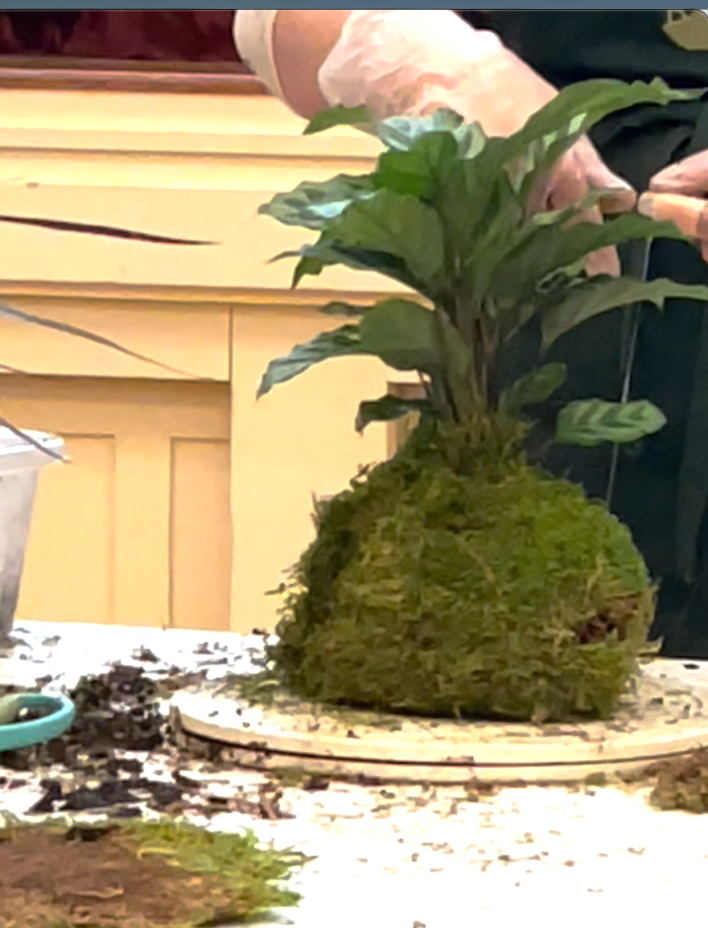Kokedama Workshop
In February, the Mission Hills Garden Club attended a workshop on Kokedama, an offshoot of Bonsai, given by Kanako Yamada. Kokedama is a plant which grows from a sphere consisting of roots covered in soil and then wrapped in colored moss. The spere represents the earth. After feasting on delicious Japanese style hors d’oeuvres, we learned how to make Kokedama and had an opportunity to purchase some plants as well as saucers to hold them.
First, we chose our plants. Like Bonsai, the roots of the plant are trimmed so they can live in a shallow pot. This means that any extra roots or tightly bound roots are carefully cut away. Then, depending on what you are planting, you prepare the soil. We put a sheet of moss, green side down, on the table. Then we mixed regular soil with just enough water to mold it into a ball. Succulents and other drought resistant plant have about 10 percent perlite added to the soil to prevent over saturation which will result in root rot.
Making the roots’ ball of dirt was hard work and required strong fingers. Wrapping the moss around that was harder still. We used fishing line to secure the ball. First, we tied the line around the top of the ball, leaving about a foot of line in the plants’ leaves which would be used to secure the finished product. Then we proceeded to tightly (but not so tightly that it would cut the moss) wrap the rest of the line around the moss, crossing the line again and again, creating a grid.
When it was finished, we tied the line to that which had been left in the plant. Mine was an absolute failure. Dirt squirted out of the moss since I failed to overlap the moss. The ball was more of an amorphous blob. Fortunately, Yamada saw my disastrous mess and deftly created a very neatly wrapped moss ball around my dirt covered roots. She did tamp the ball against the table, but gently enough to leave room for the plant to breathe.
The plant is extremely easy to care for, she said. It thrives with indirect sunlight. It is watered from the bottom. Fake moss is used as real moss needs sunlight. Since the moss is fake; the color may fade. Should that happen, a bit of green food coloring mixed with water and sprayed over dry moss will rectify the situation. Do not water the plant until it feels light when you lift it. Then, depending on the size of the plant, pour a half cup or a cup of water into a saucer and leave the plant until it has absorbed the water, about five to ten minutes. Misting it is also a good idea. “Most important,” Yamada said, “give a lotta love to the plant.” During the growing season you might want to feed it every other week with Miracle Grow diluted to about three percent of the water used. In winter, monthly watering should suffice.
These plants are hardy and should last about two to five years. You know it is time to remake the root ball or plant it in a pot when roots show or the ball becomes deformed. You may cut the moss, trim the roots, add more dirt, and wrap with moss tied with fishing wire.
If, for some reason, your plant should die, the ball is an excellent “container” for flower arrangements. She made a couple of arrangements using pussy willow and flowering fruit tree branches. That was comforting to me since I still seem to be a serial plant killer.
Don’t miss “Bees in Our Gardens” at 9 a.m., Saturday, April 23 at Mission Hills Nursery, 1525 Fort Stockton Drive. The talk will cover the life cycle of bees and will be a wonderful talk for families. It’s free to members, $5 for non-members. Please visit the website for more up-to-date information: www.MissionHillsGardenClub.org.
Saturday, May 7 is the 2022 Mission Hills Garden Walk. The theme is Homegrown. Tickets may be purchased on-line only. Get your tickets early as we sold out within a week last year.

Category: Education, Events, Gardening, Life Style, Local News, Nonprofit, Plants







